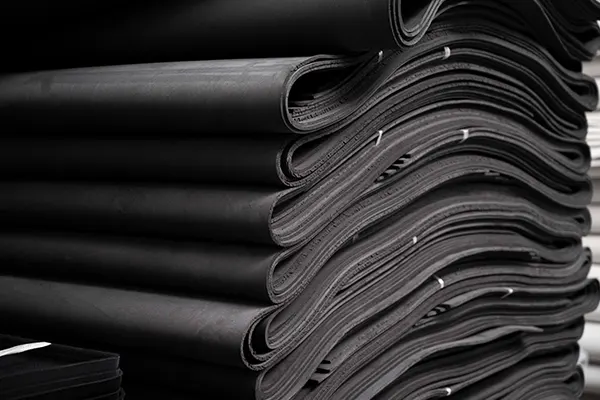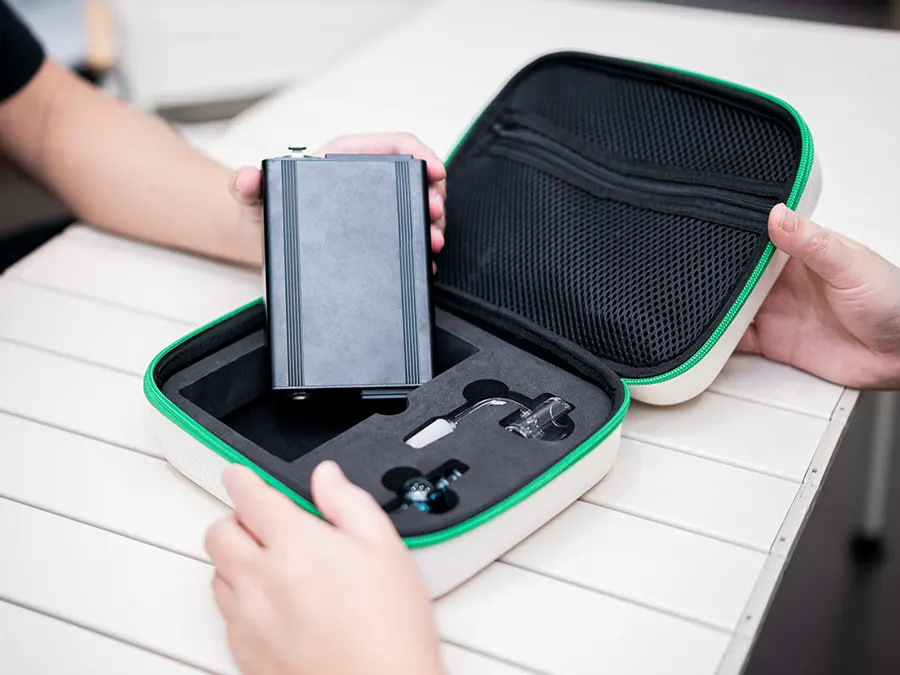Seleccionar el material adecuado para su proyecto o producto es esencial para lograr resultados óptimos. EVA y PVC son dos materiales comúnmente utilizados en diversas industrias debido a sus propiedades únicas y su versatilidad.. En esta guía completa, Profundizaremos en las características tanto del EVA como del PVC para ayudarle a tomar una decisión informada sobre cuál se adapta mejor a sus necesidades específicas.. Echemos un vistazo más de cerca a lo que distingue a estos materiales..
¿Qué es el material de Eva??

Acetato de etileno-vinilo (EVA) Es un copolímero conocido por su naturaleza ligera y flexible.. Se utiliza comúnmente en la producción de productos de espuma., como suelas de zapatos, equipo deportivo, y materiales de embalaje para producir estuches de EVA. EVA también es valorada por su capacidad de absorción de impactos., lo que lo convierte en una opción ideal para equipos de protección y aplicaciones de amortiguación..
¿Qué es el material de PVC??

Cloruro de polivinilo (CLORURO DE POLIVINILO) Es un polímero plástico sintético conocido por su durabilidad y longevidad.. El PVC es muy versátil y se puede encontrar en una amplia gama de productos., incluyendo tuberías, marcos de ventanas, piso, y señalización. Sus propiedades resistentes al agua y retardantes de llama lo convierten en una opción popular para aplicaciones en exteriores y construcción..
Propiedades del material EVA

Ligero y flexible
Una de las características más destacadas del EVA es su naturaleza ligera y flexible., lo que hace que sea fácil de trabajar y cómodo de llevar. Esta cualidad es particularmente beneficiosa en industrias que requieren que los productos sean livianos pero duraderos., como calzado y materiales de acolchado.
Capacidades de absorción de impactos
EVA es apreciada por sus excepcionales capacidades de absorción de impactos., lo que lo convierte en un material ideal para productos resistentes a impactos, como forros para cascos y acolchados protectores.. Su capacidad para amortiguar y absorber las fuerzas del impacto ayuda a reducir el riesgo de lesiones en situaciones de alto impacto..
Resistente a la intemperie
Otra ventaja del EVA son sus propiedades resistentes a la intemperie., que le permiten resistir la exposición a los elementos sin deteriorarse.. Esto convierte a EVA en una opción confiable para aplicaciones en exteriores donde la durabilidad y la longevidad son esenciales..
Inodoro y no tóxico
EVA es conocida por ser inodora y no tóxica, lo que lo convierte en una opción segura para productos que entran en contacto con la piel o los alimentos. Su naturaleza no tóxica también lo hace respetuoso con el medio ambiente., ya que no libera productos químicos nocivos al medio ambiente.
Propiedades del material de PVC
Durable y duradero
El PVC es conocido por su durabilidad y rendimiento duradero., lo que lo convierte en una opción popular para productos que requieren altos niveles de resistencia y resistencia.. Su capacidad para resistir el desgaste con el tiempo lo convierte en una opción rentable para uso a largo plazo..
Resistente al agua
Una de las principales ventajas del PVC son sus propiedades resistentes al agua., lo que lo hace muy adecuado para aplicaciones donde la exposición a la humedad es una preocupación. El PVC no absorbe agua., lo que lo convierte en una opción ideal para ambientes marinos y al aire libre.
Retardante de llama
El PVC es inherentemente ignífugo, lo que significa que tiene una alta resistencia a la ignición y no propaga las llamas fácilmente. Esto hace que el PVC sea un material preferido para aplicaciones donde la seguridad contra incendios es una prioridad., tales como construcción de edificios y cableado eléctrico.
Versátil en aplicaciones
El PVC es muy versátil y puede adaptarse para su uso en una amplia gama de aplicaciones., desde tuberías y marcos de ventanas hasta dispositivos médicos y señalización. Su versatilidad y propiedades personalizables lo convierten en un material de referencia para diversas industrias..
EVA contra. CLORURO DE POLIVINILO, cual es mejor?
Al comparar EVA y PVC, varios factores clave entran en juego:
Peso y flexibilidad
EVA es más ligero y flexible que el PVC, lo que lo convierte en la opción preferida para aplicaciones que requieren un tacto más suave y mayor comodidad.
CLORURO DE POLIVINILO, por otro lado, es más resistente y menos flexible, haciéndolo más adecuado para estructuras rígidas.
Durabilidad y longevidad
El PVC es conocido por su durabilidad y rendimiento duradero., lo que lo convierte en una opción confiable para productos que deben soportar un uso intensivo y condiciones duras.
EVA, aunque no es tan duradero como el PVC, Ofrece excelentes propiedades de absorción de impactos y amortiguación..
Resistencia a los elementos climáticos
EVA es resistente a la intemperie y puede soportar la exposición a los elementos sin deteriorarse., haciéndolo adecuado para aplicaciones al aire libre.
El PVC también es resistente a la intemperie y puede resistir la humedad y las fluctuaciones de temperatura., lo que lo convierte en una opción confiable para uso en exteriores.
Tolerancia al calor y al frío
El PVC tiene una mayor tolerancia al calor y al frío en comparación con el EVA., haciéndolo adecuado para aplicaciones que requieren estabilidad térmica.
El EVA puede ablandarse o endurecerse en temperaturas extremas., lo que puede afectar su rendimiento en ciertos entornos.
Comparación de costos
En términos de costo, El EVA es generalmente más asequible que el PVC debido a sus menores costes de producción.. Sin embargo, La durabilidad y longevidad del PVC pueden compensar la inversión inicial, lo que lo convierte en una opción rentable a largo plazo para determinadas aplicaciones.
Aplicaciones en industrias
Tanto EVA como PVC encuentran una amplia gama de aplicaciones en diversas industrias.:
Aplicaciones EVA
- Calzado: EVA es un material popular para fabricar suelas y plantillas de zapatos debido a su ligereza y propiedades de absorción de impactos..
- Equipamiento deportivo: EVA se utiliza en la producción de acolchados deportivos., cascos, esteras, y empuñaduras para equipos deportivos.
- Equipo de protección: La absorción de impactos superior del EVA lo convierte en un material ideal para crear equipos de protección, como forros para cascos y acolchados para equipos deportivos y de seguridad..
- Materiales de embalaje: EVA también se utiliza en la fabricación de materiales de embalaje., incluido Estuches rígidos de EVA para electrónica, herramientas, y artículos delicados.
Aplicaciones de PVC
- Tubería: Los tubos de PVC se utilizan mucho en fontanería., riego, y sistemas de drenaje por su durabilidad, resistencia a la corrosión, y facilidad de instalación.
- Marcos de ventana: El PVC es un material habitual para la fabricación de marcos y perfiles de ventanas debido a su resistencia a la intemperie., bajos requisitos de mantenimiento, y eficiencia energética.
- Piso: suelos de PVC, incluyendo baldosas de vinilo y pisos de tablones de vinilo, es popular por su durabilidad, resistencia al agua, y amplia gama de diseños.
- Aislamiento eléctrico: El PVC se utiliza en aplicaciones eléctricas para aislamiento de cables., alambrado, y conductos eléctricos debido a sus propiedades ignífugas y aislantes..
- Señalización: Las láminas y tableros de PVC se utilizan habitualmente para señalización interior y exterior debido a su durabilidad., resistencia a la intemperie, y facilidad de personalización.
EVA contra. CLORURO DE POLIVINILO, Cuál elegir?
A la hora de decidir entre EVA y PVC para tu proyecto o producto, considere los siguientes factores:
- Si priorizas la ligereza y la flexibilidad, EVA puede ser la mejor opción.
- Para aplicaciones que requieren durabilidad y longevidad, El PVC puede ser más adecuado.
- Resistencia a la intemperie, tolerancia al calor, y las consideraciones de costos también deben guiar su decisión.
Conclusión
En conclusión, Tanto EVA como PVC ofrecen propiedades y beneficios únicos que los convierten en materiales valiosos en diversas industrias.. Comprender las diferencias clave entre EVA y PVC, como el peso, flexibilidad, durabilidad, resistencia a la intemperie, y costo, Le ayudará a tomar una decisión informada sobre qué material se adapta mejor a sus necesidades específicas.. Ya sea que elija EVA o PVC, ambos materiales aportan versatilidad, actuación, y confiabilidad para una amplia gama de aplicaciones.
















